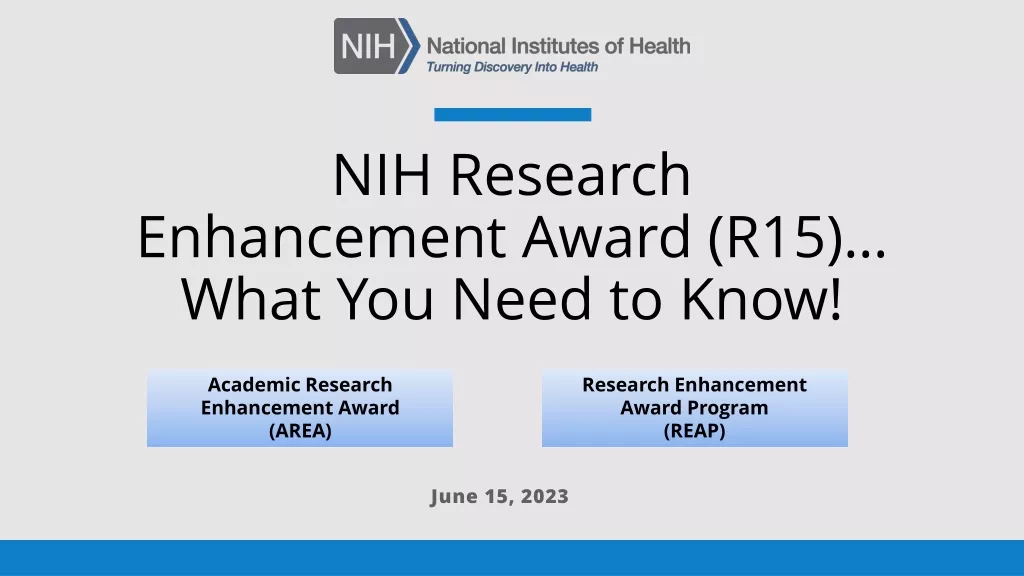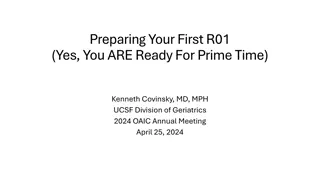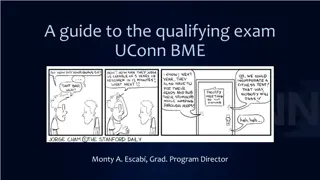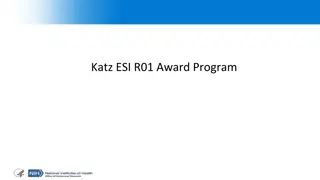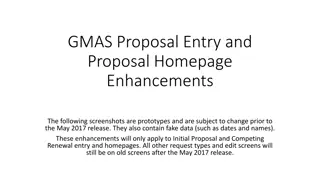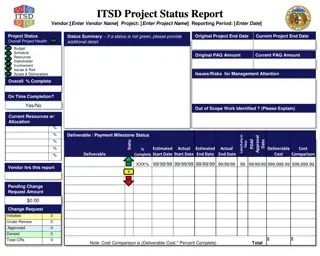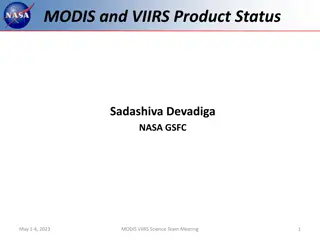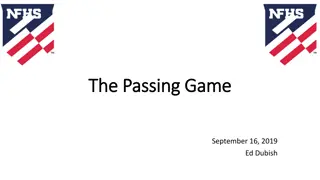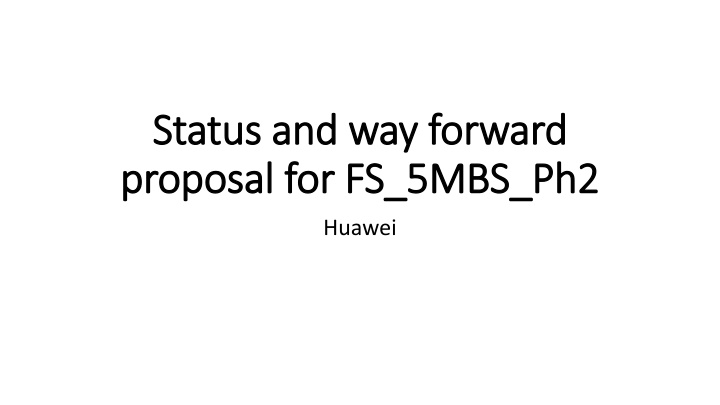
Proposal for FS 5MBS Phase 2 Review and Way Forward
Review the work plan for KI#1 and KI#2, examine LS responses from RAN2 and RAN3, assess current status, propose the way forward, and plan for the next meeting. Stay updated with SA2#154 output and discuss TR 23.700-47, TS 23.247, TS 23.501, TS 23.502, and TS 23.503. Join the meeting to participate in the discussions.
Download Presentation

Please find below an Image/Link to download the presentation.
The content on the website is provided AS IS for your information and personal use only. It may not be sold, licensed, or shared on other websites without obtaining consent from the author. If you encounter any issues during the download, it is possible that the publisher has removed the file from their server.
You are allowed to download the files provided on this website for personal or commercial use, subject to the condition that they are used lawfully. All files are the property of their respective owners.
The content on the website is provided AS IS for your information and personal use only. It may not be sold, licensed, or shared on other websites without obtaining consent from the author.
E N D
Presentation Transcript
Status and way forward Status and way forward proposal for FS_5MBS_Ph2 proposal for FS_5MBS_Ph2 Huawei
Agenda Agenda Review the work plan For KI#1 and KI#2 Review the LS responses from RAN2 and RAN3 (if any); Current status of the conclusion; Way forward proposal; Plan for the next meeting WID update as per the output of SA2#154. TR 23.700-47; TS 23.247; TS 23.501; TS 23.502; TS 23.503. AOB. Click here to join the meeting
Work plan review Work plan review Feb, 22 Apr, 22 May, 22Aug, 22 Oct, 22 Nov, 22 Jan, 23 Feb, 23 Normative TU Total TU SID/WID Study TU Total TU#149 #150 #151 #152 #153 #154 #154AH#155 12 FS_5MBS_Ph2 7.5 4.5 12 1 1 2 2 1 1 2 2 SA2#149e, Feb (1TU): Focus on KIs, solutions are allowed. Agree the skeleton/scope/architectural assumption. SA2#150e, Apr (1TU): Focus on Solutions and complete all KIs. Potential updates/new KIs. Last meeting for KI proposal/modification. SA2#151e, May (2TUs): Solutions SA2#152, Aug (2TUs): Solutions, evaluations, conclusions SA2#153, Oct (1TU): Solution updates (No new Solutions), evaluations, conclusions: Approval of MBS_Ph2 WID. SA2#154, Nov (0.5 TU): final conclusions: Adjustment/issues depends on RAN progress, update of the WID. NOTE: In SA2#154 meeting, we have to re-arrange the TU allocated for study/normative phase, so 0.5 TU is not the exact number. Observation: Conclusion for each KI shall be made in next meeting.
KI#1 KI#1 Q#1a: If there are significant differences in the quality and reliability of the reception of MBS data between UEs in RRC Connected state and UEs in RRC Inactive state. The quality and reliability of the reception of MBS data between UEs in RRC_CONNECTED state and UEs in RRC_INACTIVE state may or may not be different, as HARQ feedback and PTP transmission are not supported and seamless/lossless mobility is not required for multicast reception in RRC_INACTIVE. RAN2 The QoS requirements apply to the provision of the multicast session, independently from the strategy a gNB applies to achieve their fulfilment. RAN3 Observation: RAN: Either RRC Inactive or RRC Connected shall both fulfil the quality and reliability of the QoS requirement of MBS session. With RRC Connected status, the quality and reliability may or may not be different. Proposal: QoS requirements is taken account into when deciding the RRC status of the UEs. Take the answers into account when making conclusion.
KI#1 (Contd) KI#1 (Cont d) Q#1b: If it is possible, as part of the same MBS session, to have some UEs receiving in RRC Connected state, while other UEs receiving in RRC Inactive state. Yes, it is supported that gNB transmits service of one multicast session to both UEs in RRC_CONNECTED and UEs in RRC_INACTIVE in the same cell. It is assumed the gNB can choose which UEs receive in RRC_CONNECTED and which in RRC_INACTIVE. RAN2 Yes, this is RAN3 assumption and aligned with RAN2 agreement that It is supported that gNB transmit one multicast session to both UEs in RRC_CONNECTED and RRC_INACTIVE in the same cell. RAN3 Observation: Both RAN2 and RAN3 confirm the possibility asked by SA2. RAN nodes determine to switch the individual UEs to RRC Inactive/connected state. Proposal: RAN nodes can make decision on switching the UE connected status in a per UE level. Clarify that UE-level assistant info is needed, whether existing parameters can be reused is FFS.
KI#1 (Contd) KI#1 (Cont d) Q#1c: If the answer to Q1-b) is yes, will a UE incur MBS data loss while transitioning (under NG- RAN control) between RRC Connected state and RRC Inactive state in the middle of MBS data session? If yes, how long can the reception outage be There may or may not be interruptions and data loss during state transition, depending on the solution to provide the PTM configuration and also network implementation. RAN2 RAN3 N/A Observation: it is RAN related issue. Proposal: No further study work is needed for SA2 in Rel-18. If there is any future input from RAN WGs, it can be handled as alignment.
Observation: RAN responds that: Session level information: can reuse current existing parameters (e.g. ARP, 5QI). UE level information: cannot use existing QoS parameters, and SA2 to further determine the mechanism. Proposal: SA2 determines the detailed mechanism in 154. KI#1 (Cont d) KI#1 (Cont d) Q#1d: Whether the existing QoS parameters of MBS QoS Flow(s) are enough or some additional parameter is needed for NG-RAN to differentiate different MBS session and UE, which can be used by NG-RAN to decide how to deliver the MBS data and Q2 SA2 would like to receive feedback on the value of such assistance information from RAN perspective. Q#2: SA2 would like to receive feedback on the value of such assistance information from RAN perspective For the MBS session handling: the existing MBS session QoS parameters (e.g. ARP, 5QI) can be reused to differentiate different MBS sessions to decide whether the corresponding services can be provided to RRC_INACTIVE UEs. For the case of differentiating different UEs: as the MBS session related QoS parameters are the same for different UEs within the same MBS session, the existing QoS parameters of MBS QoS Flow(s) cannot be used by NG-RAN to differentiate the handling for different UEs. FFS whether additional assistance information is needed, if the handling for different UEs needs to be differentiated which is up to SA2. RAN2 The gNB decides whether a UE is configured to receive multicast data in RRC_INACTIVE. The gNB may take at least the following information into account when deciding to enable UEs receiving multicast in RRC_INACTIVE state: the radio capabilities of the UE (whether multicast over RRC_INACTIVE is supported) multicast context information (e.g. the QoS parameters not associated to any specific UE) information available locally at the gNB (e.g. cell load) RAN3
KI#1 (Contd) KI#1 (Cont d) Q#3: SA2 would like to ask if the UE radio capability provided directly from UE to NG-RAN will contain the information whether the UE supports Rel-18 MBS capability to receive multicast data in RRC_INACTIVE state Yes, the UE radio capability indicating support of multicast reception in RRC_INACTIVE state can be reported to RAN, which is subject to the discussion of UE radio capability. RAN2 RAN3 Observation: RAN uses radio capability in AS layer, and the details depends on the work of RAN WGs. Proposal: No further study work is needed for SA2 in Rel-18. If there is any future input from RAN WGs, it can be handled as alignment.
KI#1 (Contd) KI#1 (Cont d) Q#4: SA2 would like to clarify with RAN WGs whether the assumption that IDLE UE will need to transition to connected state to start receiving the MBS data and CN initiated group paging (as defined in Rel-17) is thus still required for such UEs Yes, the UEs in RRC_IDLE need to be transitioned to RRC_CONNECTED state to start receiving the MBS data and thus the CN initiated group paging is still needed to be performed. RAN2 Yes, an idle UE will need to transit to connected state and thus, , the CN initiated group paging still needs to be performed. RAN3 Observation: RAN WGs assume CN initiated group paging is needed for session activation, so as to notify the UEs in RRC_IDLE mode UEs. Proposal: CN initiated group paging is needed for session activation. Take this aspect into account for conclusion.
KI#1 (Contd) KI#1 (Cont d) Q#5: When MBS Session is activated and MBS data allowed to be received in RRC_INACTIVE state, is it possible that the RRC_INACTIVE UE receives MBS data without going back to RRC connected state? If possible, when the MBS session is being activated, how is the RRC_INACTIVE UE notified. For group paging initiated for IDLE UEs, does RRC_INACTIVE UE respond to such paging It is possible that the RRC_INACTIVE UE receives MBS data without going back to RRC_CONNECTED state when the MBS session is being activated provided the UE has already joined the multicast session and the UE has valid MRB configuration. As a baseline, group paging can be used to inform the RRC_INACTIVE UE(s) about the session activation. The details are still under discussion in RAN2. For group paging initiated for UEs in RRC_IDLE state, per Rel-17 specification, the RRC_INACTIVE UEs will also respond if they receive the corresponding paging message. However, for Rel-18, if the MBS session can be received in RRC_INACTIVE state, the RRC_INACTIVE UE need not go back to RRC_CONNECTED state if the UE has already joined the multicast session and the UE has valid configuration. It is FFS how to avoid these UEs going back to RRC_CONNECTED state when the CN group paging is received. RAN2 RAN3 N/A Observation: RAN2 responds that: During session activation, RRC_INACTIVE UE receives MBS data without going back to CONNECTED Group paging can be used to inform the RRC_INACTIVE UE(s) about the session activation. Proposal: Have a general description but needs further checking, also checking current wording is sufficient or not. Details depends on RAN.
KI#1 (Contd) KI#1 (Cont d) Q#6: SA2 would like to confirm with RAN WGs the above assumption: Regarding the mobility within the RAN Notification Area (RNA), SA2 assumes the UE in RRC Inactive state should be able to continue receiving DL multicast MBS data within its RNA and the solution will be determined by RAN WGs as RRC_INACTIVE mobility is under the remit of RAN WGs RAN2 has made the following agreements: Multicast service continuity after cell reselection in RRC_INACTIVE state (i.e. without resuming RRC connection) will be supported (if the configuration for the multicast session in the new cell is available for the UE). Upon cell reselection to neighbor cells during active multicast session, if the configuration of the session is not available for the new cell for UEs in RRC_INACTIVE, then the UE is required to resume RRC connection to get the Multicast MRB configuration. RAN2 NG-RAN signalling supports service continuity for UEs receiving multicast session data in RRC_INACTIVE, i.e., a UE is able to continue multicast reception without RRC state transitioning after cell reselection in RRC_INACTIVE state if the configuration of the new cell is available for the UE. Impact on network interfaces is FFS. Details are under discussion in RAN2 and RAN3. RAN3 Observation: Mainly issue of RAN WGs. UE may or may not switch back to RRC Connected mode after cell reselection, depends on the availability of configuration at UE and the MBS session is activated. Proposal: Take this aspect into account for conclusion. If there is any future input from RAN WGs, it can be handled as alignment. Check if any general description align with RAN LS is needed.
KI#2 KI#2 Q#7: SA2 would like to know if RAN considers any aspects of the proposed solutions for KI#2 as not feasible or desirable from RAN perspective RAN2 RAN2 would like to leave this question for RAN3 to respond. A solution based on information received from 5GC is desired to enable gNB to be aware of the same MBS service in case of MOCN. Solutions #2, #7, #24 and #29 can work, while solutions #2, #7 with majority support in RAN3. Besides, RAN3 also achieved the following agreements: The solution should not have impact on Rel-17 UE and Rel-17 gNB The identity providing a reference to the same MBS service should not depend on the momentarily participating operators considering of the possibility for sharing operators leaving or entering the common ongoing session from time to time, that s to say the solution should be robust to cover the cases that the shared PLMNs start and stop the MBS session at the same time and start and stop the MBS session at the different time It could not be assumed that MB-SMF/AF/MBSF is aware which NG-RAN node or which cell within a NG-RAN node is sharedsince currently NG-RAN node only inform AMF of the supported PLMN and no coordination with MB-SMF/AF/MBSF Solution 24 brings configuration efforts which may have flexibility and scalability issue in case MBS services are dynamically added or removed RAN3 Observation: RAN3 provides several principles: And Reduces the candidate solutions to 3 (or 2?) Proposal: Down-selection the solutions among the feasible solutions (which are already confirmed by RAN3) in SA2 considering the majority support of Solution #2 and #7 from RAN3.
Plan for the next Meeting Plan for the next Meeting WID update as per the output of SA2#154. TR 23.700-47: Finalize the conclusion; TS 23.247: Scope update (?); Update regarding KI#4; TS 23.501: (TBD) Potential update for RRC Inactive data reception. Group message delivery. TS 23.502 (TBD) Update on the service. TS 23.503 (TBD): Rel-17 we don t have reference for MBS in 23.503.
AOB AOB Another offline CC before 154? e.g., 9thor 10thNov. Purpose: collect the view and have the way forward. Drafting session on Tuesday early morning , TBD? Others?
Thank you! Thank you!

